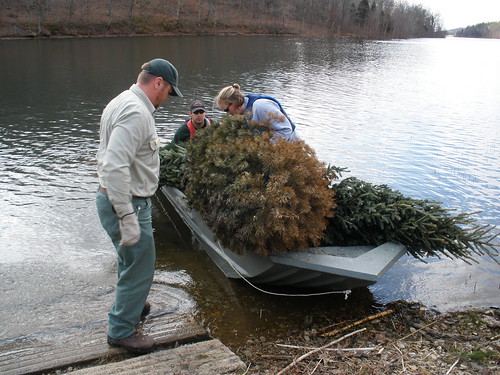
For many, purchasing or cutting a Christmas tree is a favorite seasonal tradition. But what do you do with your trees after the festivities end?
Tree recycling after the holidays has become part of community traditions on several Eastern Region national forests. Recycled trees can be used to establish fish habitats, create mulch for future plantings and build soil erosion barriers. Using the trees for these purposes also keeps them from filling up local landfills.
Land managers of several national forests in the area have found that the old Christmas trees can be used to make a cozy home for schools of fish. Fish habitats create ideal spawning grounds to ensure successful reproduction, a place of refuge and shade for the young, and shelter from predators. Also, fish habitats provide a food source – a breeding ground for algae and plankton to attract bait fish and lure larger fish to favorite fishing spots.
Since 1983, the Allegheny National Forest in Pennsylvania has worked with the Kinzua Fish and Wildlife Association and the U.S. Army Corps of Engineers on various recycling projects. According to association, more than 19,500 Christmas trees were used to improve fish habitat in the Allegheny Reservoir.
The Ironton District recycle program on the Wayne National Forest and the Ohio Department of Natural Resources- Division of Wildlife annually collect 240 trees and place bundles of three to four trees either in Lake Vesuvius or Timbre Ridge Lake for fish habitats.

The Chequamegon-Nicolet National Forest in Wisconsin has used recycled Christmas trees for fish habitat improvement projects for many years. In the city of Washburn, trees are recycled twice — first to mark the trail for the annual Book across the Bay 10K ski race across Lake Superior’s Chequamegon Bay in February, and then later to construct other fish habitats like fish cribs, half logs and pyramid brush structures.
On the Hoosier National Forest, the Tell City Ranger District has recycled Christmas trees in Perry County, Indiana for six years. They place trees in Tipsaw, Indian, Celina, and Saddle lakes, as well as German Ridge Pond for fish habitat.
Contact your nearest national forest or grassland to see if they, too, recycle Christmas trees. Other great resources for recycling trees are the National Christmas Tree Association and the Arbor Day Foundation.
End a great season, by giving back to nature.

